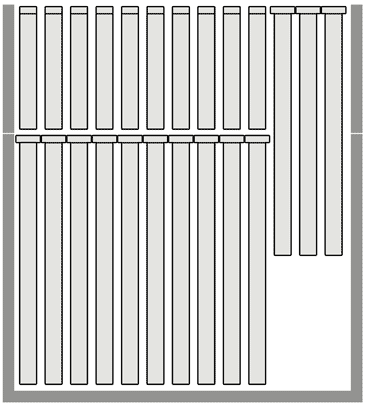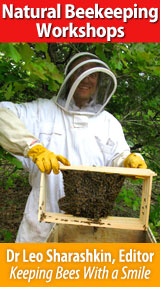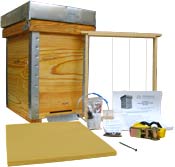If Bees Run out of Room – WHAT TO DO – Free Guide
LAYENS HIVES AND FRAMES AVAILABLE FROM OUR STORE >>
Hives include all frames, fully assembled & ready to go
Layens horizontal hives have smaller volume than the commercial vertical hives. This is good because bees living in smaller cavities stay healthier than in very large ones. But this also means that an overwintered colony or a strong early swarm will completely fill a 12-frame or 14-frame Layens hive by late spring. In a good year even the 20-frame insulated hive may be bursting at the seams, overflowing with bees, brood, and honey.
If you do nothing, the colonies will swarm (possibly more than once), meaning the loss of bees and smaller honey crop. Also, as bees bring in a lot of nectar, the brood nest may become honey bound (i.e. most cells are used for honey and the queen has nowhere to lay, weakening the colony). Finally, bees may build comb inside the lid — as Layens mentioned in Keeping Bees in Horizontal Hives.
So for best results stay ahead of the bees and don’t let them run out of room. You can tackle this challenge to your — and bees’ — benefit, increasing the number of colonies and honey harvest at the same time. There are several good options for that:
1. Pick a hive with the right volume for your local conditions (how much nectar bees can bring), for the amount of time and attention you want to devote to your bees (larger hives require less work), and for your priorities (more honey vs. quickly growing the number of your colonies). A 20-frame insulated Layens hive works well for a more hands-off approach: gradually increase the number of your colonies by making one artificial swarm in the spring (see next point), then leave your bees alone to bring in a good honey crop. One the other hand, the 12-frame and 14-frame Layens hives work great for multiplying the number of your colonies quickly, for your own operation or for sale, by creating several artificial swarms each spring and summer. (The lighter weight of these smaller hives also helps because many artificial swarming techniques call for hives to be moved.)
Please note that in very favorable locations — for example, if you regularly harvest 200 lb of honey per hive per year — you will need a larger hive or more intensive management. I have seen 32-frame Layens hives in Spain (this is equivalent to 40 deep Langstroth frames); Fedor Lazutin used 36-frame Layens hives as shown in Keeping Bees with a Smile (2nd Edition). But these huge hives are very heavy, expensive, and next to impossible to move. All-in-all I’m finding the classical Layens hives much more practical and versatile: the 20-frame Layens for honey, the 12-framer for bee breeding, and the 14-frame hive somewhere in between.
2. Make artificial swarms in a timely manner. Highly recommended. Many excellent simple techniques are described by Georges de Layens. In particular, “artificial swarming with two hives” (Keeping Bees in Horizontal Hives, p. 185) works really well. If the colony has at least 7 frames of brood early in the season and the weather is reliably warm, making an artificial swarm with one hive (Keeping Bees in Horizontal Hives, p. 258) is another good option. You can double the number of your colonies and increase honey harvest at the same time — without ever having to find the queen! See even more methods in Raising Honeybee Queens. With some experience you will know what combination of artificial swarm size and timing produces the best result and creates colonies that do not outgrow their homes that summer. For example, in the Ozarks of southern Missouri (Zone 6) if my 14-frame Layens hive is full by early May (9 frames of brood, 5 frames of honey & pollen, and lots of bees), splitting it in half will produce two strong colonies that will run out of room again by late June. However, splitting it in three parts (3 frames of brood each plus 1–2 frames of reserves) will create robust colonies that usually won’t outgrow their 14-frame hives.

4. Harvest honey early. Normally you harvest honey from Layens hives at the very end of the season. But if the hive is really full in mid-season, you can harvest honey frames, extract, then return extracted frames to the bees to refill. Pulling honey from a very active hive boiling over with bees is no fun. Besides, many honey cells may be uncapped, in which case spin frames gently before uncapping, drain this nectar from the extractor, then uncap and extract the ripe honey — see the Layens book for details. Overall this is not an ideal approach. This partial harvest may not be enough to prevent the hive from becoming honey bound (no room for the queen to lay), so when you return the extracted frames to the bees, you would want to position them strategically — some in the honey section of the hive among the other honey frames, and a couple frames next by open brood, to give the queen room to continue egg laying. But this means a major hive inspection, which can be done but involves a lot of work and disruption — two things we want to avoid.
5. Equalizing colonies means taking resources (brood, food, or bees) from one hive and giving it to another. These techniques can be useful for two small colonies, but taxing the prosperous to support the weak is not a good idea — the poor tend to remain poor, and trying to help them at the expense of the rich you are weakening your best hives. Besides, each method of strengthening the weak has its downsides: a) If you borrow brood frames from a very strong colony, making the right decision on which frames to take requires a major hive overhaul. b) If you swap the hives places so the weaker hive catches all the foragers of the stronger hive, these foragers may kill the weaker hive’s queen that they don’t recognize. c) If you shake bees into the weak hive, you need to be absolutely sure the strong hive’s queen is not on the frame, etc. A lot of work that is often counterproductive. Don’t do it!
In summary: Pick a hive with the right volume for your needs (consider local honeyflows, desired frequency of hive visits, and a balance between your bee breeding and honey production interests). Then before the bees run out of room, perform timely artificial swarming (see the Layens book) and — in especially honey-rich locations or in exceptionally good years — add a super on top of your horizontal hive after the bees have filled the main box with brood and honey and start bearding outside the entrance.
LAYENS HIVES & FRAMES AVAILABLE FROM OUR STORE >>
Hives include all frames, fully assembled & ready to go
Many more guides are in progress, so please join our email list below for more free advice and important updates (no spam; only 2-4 emails per year, and you can unsubscribe at any time). THANK YOU! – we’re working hard to bring you the bees... and the smile!
— Dr. Leo Sharashkin, Editor of “Keeping Bees With a Smile”







